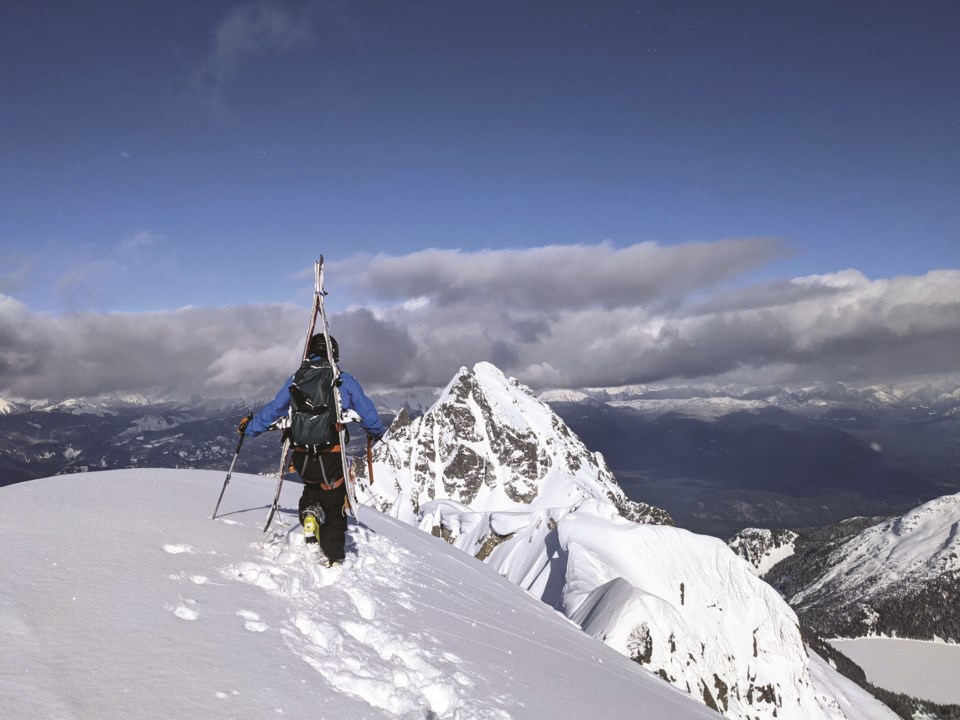Of all the zones I’ve ski toured over the years in the Sea to Sky, one stands head and shoulders above them all: the Tantalus Range. When people drive (or are shuttled) up the Sea to Sky Highway for the first time, it’s likely Mount Tantalus atop the Rumbling Glacier that leaves the most imposing impression of mountain magnitude. Not the Chief, not Mount Atwell, not Wedge Mountain. Only when you take in the winding couloirs of Mount Currie are you in the same ballpark as the Tantalus Range in golden light.
The hub of mountain activity in the Tantalus is the Jim Haberl Hut, a 12-person lodge run by the Alpine Club of Canada-Vancouver Section and built in 2006. The hut’s namesake is Whistler mountaineer Jim Haberl, one of the first two Canadians to climb K2, and who died in an avalanche in Alaska in 1999.
The Jim Haberl Hut, and by association the surrounding stretch of the Tantalus Range, has primarily serviced summer mountaineers over the years, but adventurous skiers looking to descend those mountains knew what doors would open with an alpine hut in such a location. That’s the thing about the Tantalus. It’s not really a ski-touring zone. It’s a ski mountaineering zone, warts and all.
Gaining summits and skiing them isn’t really practical along the jagged, sawtooth ridges, not like the relatively forgiving mountains you’ll find in the Spearhead Range or along the Duffey Lake Road. The terrain choices in the Tantalus are either super mellow meadow skipping down the glaciers (akin to heli-ski terrain) or some of the steepest, most formidable lines in the Sea to Sky. Skiers who shell out for the return helicopter flight have to come equipped not only with the requisite avalanche safety gear, but a full glacier travel kit including ropes, harnesses, slings, crampons (ski and boot both) and an ice axe.
When you get your first close-up of these mountains under the whirring blades of the heli, it starts to make sense. Crevasse fields litter the glaciers. Gaping bergschrunds threaten to swallow you whole. Avalanches are an ever-present hazard, not only from burials but the potential to send you hurtling off one of the many exposed cliffs. With heli-assisted ski touring well and truly in its Golden Age, there are plenty of skiers who simply want to be around these mountains, even if the skiing they end up enjoying is relatively mellow.
There are also plenty of skiers that like to get after it, comfortable with the high-risk, high-reward stakes.
I hadn’t skied the Tantalus in a few years. The Jim Haberl Hut (in normal, non-COVID operation) is booked pretty solid for a lot of the prime spring season and it can be hard to find a spot unless you book weeks or months ahead, with no idea what the weather is going to bring. But with safety protocols in place and a firm lock on the hut’s door, the only option for multi-day ski trips to the Tantalus is to winter camp.
A friend called me last Thursday, April 8, with exciting news: He had a heli arranged for a two-day, one-night Tantalus trip. I figured it was time to remind myself why I fell in love with this mythical mountainscape in the first place. Here are some reminder lessons that I took away from my weekend.
If you boot pack on anything that gets a fair share of sun throughout the day, get those boot crampons on your feet. Things get steep very quickly, which isn’t always apparent when you scope the route or even when you’re at the bottom of the bootpack looking up. Rocks can be thinly covered with snow and ice; when you strike that surface with your ski boot you’ll be thankful for the pronged teeth by your toes.
Ridges in the Tantalus typically aren’t great travel. If you find a safe route up and want to descend a line that’s a few hundred metres further up or down the ridge, the terrain will often have other ideas and greet you with impassable cliffs, knife-edge exposure and looming cornices.
Speaking of cornices, the coastal winds in the Tantalus will form these snow/ice monsters to the size of tiny homes. Expect them everywhere and never peer off the edge without roping up.
While you may be confident in your snowpack assessment, surface sluff on these steep faces can take you for a ride just as easily. Ski the steeps accordingly.
Like any ski touring trip, have the topo maps to cross reference your GPS positioning. Allow extra time for more complex route finding. Navigation is tricky for anything you don’t have direct sightlines for.
The Tantalus is a place where the money to hire a qualified mountain guide would be best spent. My first two trips there were with a ski guide or apprentice ski guide and I enjoyed the trip a lot more as a result. If you have a few years ski touring under your belt and feel confident sending the steeps, your first trip to the Tantalus could use some guidance, especially if no one in the party has travelled there before.
There’s glory to be found in the Tantalus, but it’s no place for cowboys looking to get rad. Like any mountain range, it takes a few trips to familiarize yourself enough to feel your way around with any confidence. In the Tantalus, mistakes and unpreparedness are punished severely by the mountains themselves. Enjoy your time there, and ski accordingly.
Vince Shuley had a great weekend among giants. For questions, comments or suggestions for The Outsider email [email protected] or Instagram @whis_vince.





